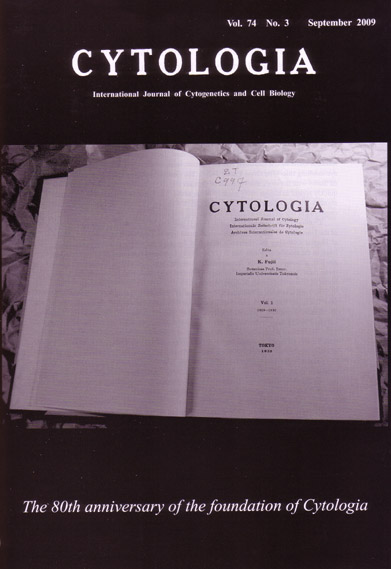| ON THE COVER |  |
|---|---|
| Vol. 74 No.3 September 2009 | |
| Anniversary | |
|
|
|
| The 80th anniversary of the foundation of Cytologia The title page of this issue is a photograph of the first page of the first issue of Cytologia preserved in the Kashiwa Library of the University of Tokyo. Cytologia started 80 years ago, in August 1 929. The year when Cytologia was first published,1929, was an important year. John Kenneth Galbraith, a Canadian American economist, wrote a best-selling book with the eye-catching title "The Great Crash, 1929". The Great Depression originated in the United States with the stock market crash of October 29, 1929 (known as Black Tuesday), but quickly spread to almost every country in the world. The Great Depression affected Japan strongly and the Japanese economy shrank by 8% during 1929-31 ; furthermore, the unemployment rate in Japan exceeded 20% during that time. Cytologia was founded by Kenjiro Fujii (1866-1952), who was a professor emeritus of the University of Tokyo, during a very difficult time in Japan. It became an international journal following the strenuous efforts of Japanese researchers, including K. Fujii. Even in the middle of World War ćU (1939-1945), Cytologia continued to be published in English, although it was the language of the enemy, and was sold in dollars. We know these facts from postscripts to Cytologia from that time. This may have been due to the honor in which the founder, K. Fujii, was held. K. Fujii was born in Kanazawa, the capital of Province Kaga, at the end of the 265 year Tokugawa Era, which ended with the Meiji Restoration of 1868. He graduated from the Botanical Institute, Faculty of Science, Tokyo Imperial University, in 1882. He studied plant morphology and cytology in Germany and Britain, and then returned to Japan in 1904. He became a professor in the Department of Plant Morphology, the Botanical Institute, Faculty of Science, Tokyo Imperial University, in 1911. K. Fujii continued to work in cytogenetics and plant morphology, and established the Department of Genetics in the Botanical Institute in 1918. This redbrick was the first genetics department in Japan. He retired in 1927. K. Fujii is well known for translating "gene" into "idenshi" in Japanese and for discovering the spiral structure of chromosomes in the cell nucleus. In 1950, he was awarded the Order of Culture, which is the highest prize in Japan. Finally, we would like to acknowledge the Japan Mendel Society, Wada-Kunkou-kai, and the Ministry of Education, Culture, Sports, Science, and Technology of Japan for supporting the publication of Cytologia. The first two organizations were established by Yosito Sinotô and Bungo Wada, respectively. They were also active contributors to Cytologia, when it was founded. (Shigeyuki Kawano l,2ü@1Editor-in-Chief of CYTOLOGIA, ü@2Department of Integrated Biosciences, Graduate School of Frontier Sciences, University of Tokyo, 5-1-5 Kashiwanoha, Kashiwa, Chiba, 277 -8562, Japan) |
|